Latest CoStar Composite Price Indices Ticked Up In Third Quarter
CCRSI RELEASE – October 2019
(With data through September 2019)
Print Release (PDF)
Complete CCRSI data set accompanying this release
This month's CoStar Commercial Repeat Sale Indices (CCRSI) provides the market's first look at commercial real estate pricing trends through September 2019. Based on 1,371 repeat sale pairs in September 2019 and more than 216,000 repeat sales since 1996, the CCRSI offers the broadest measure of commercial real estate repeat sales activity.
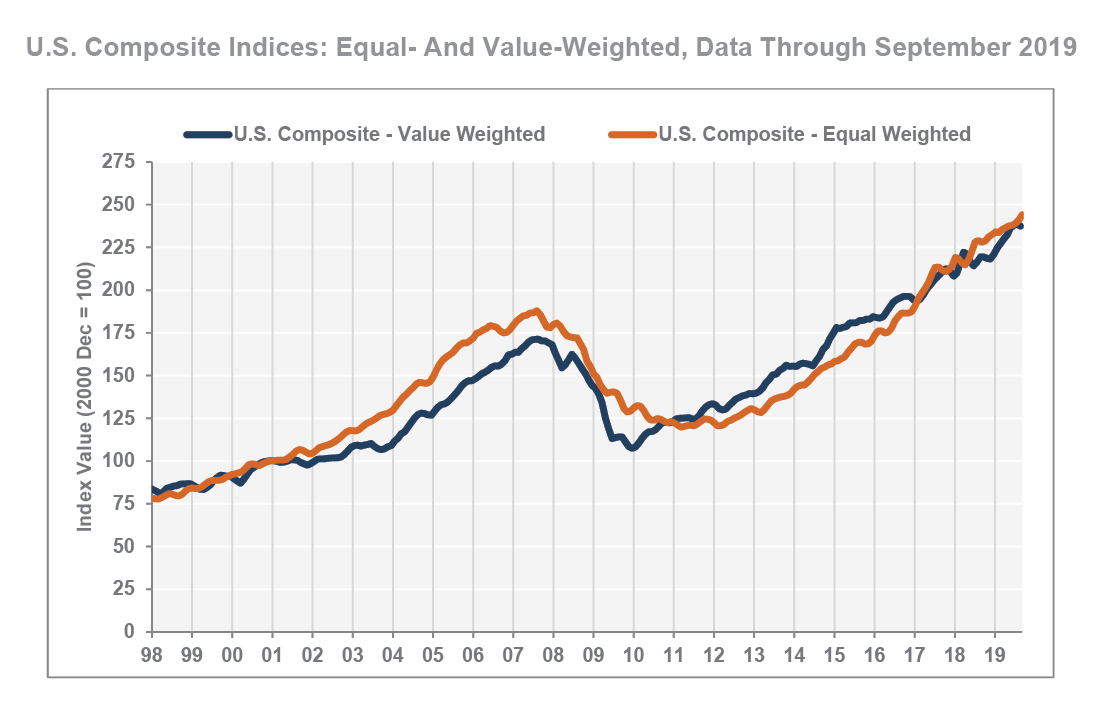
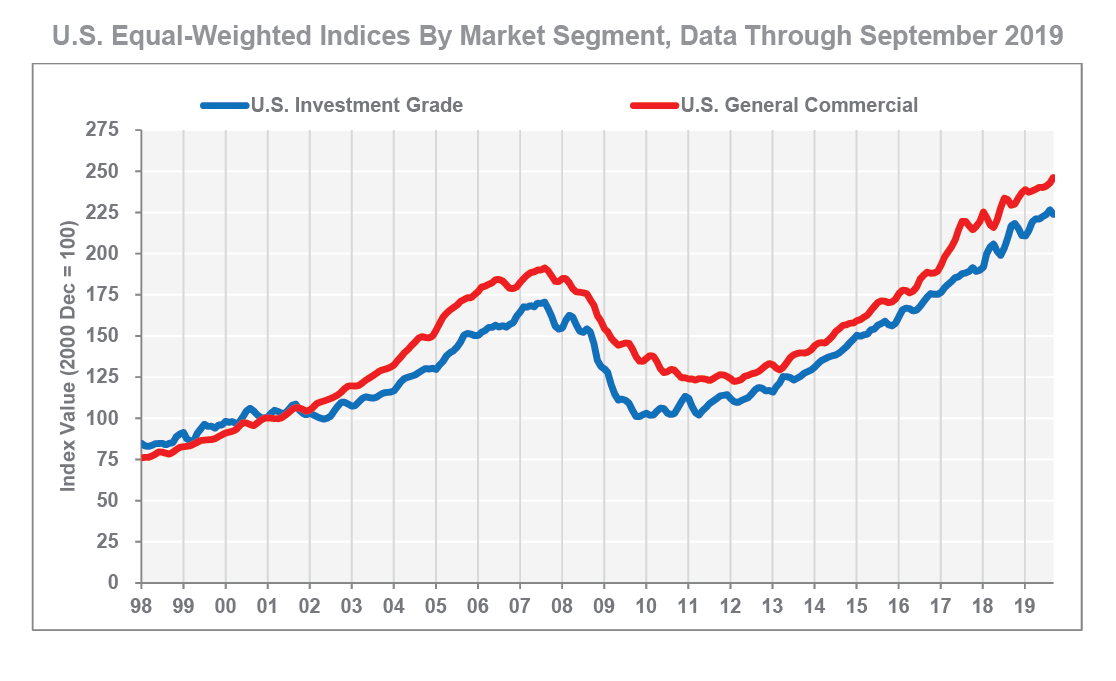
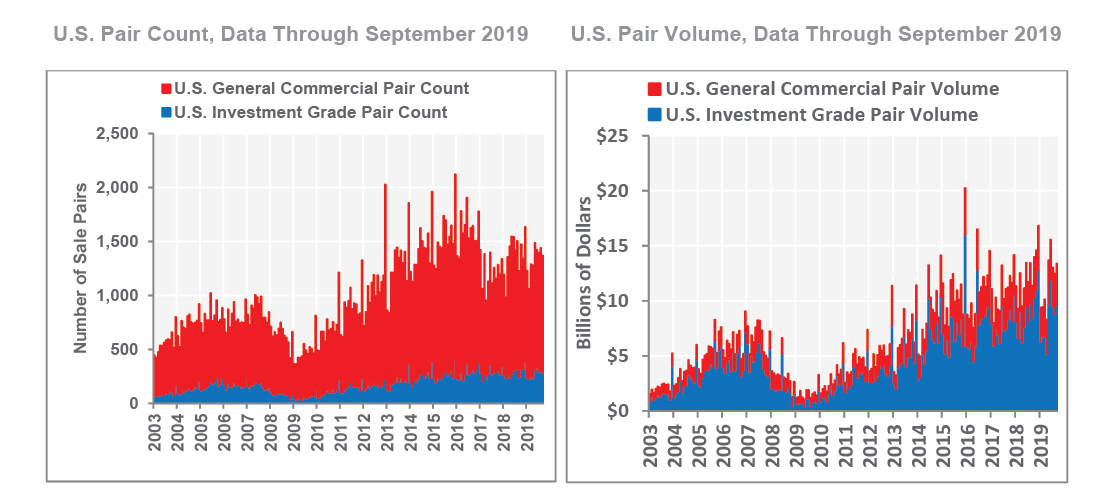
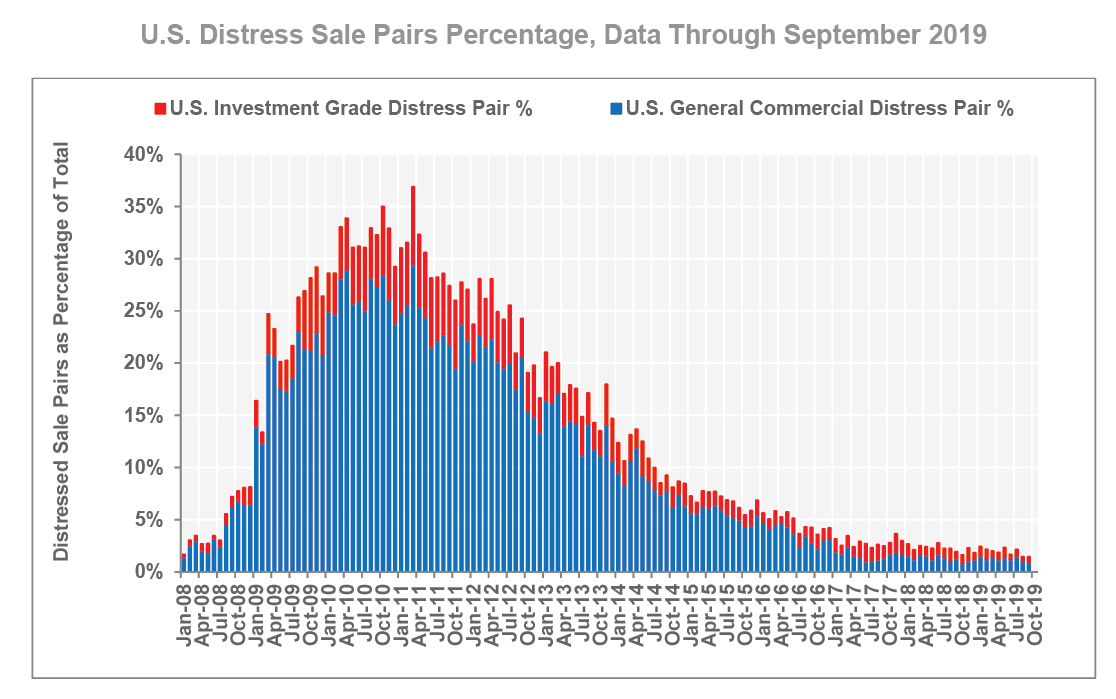
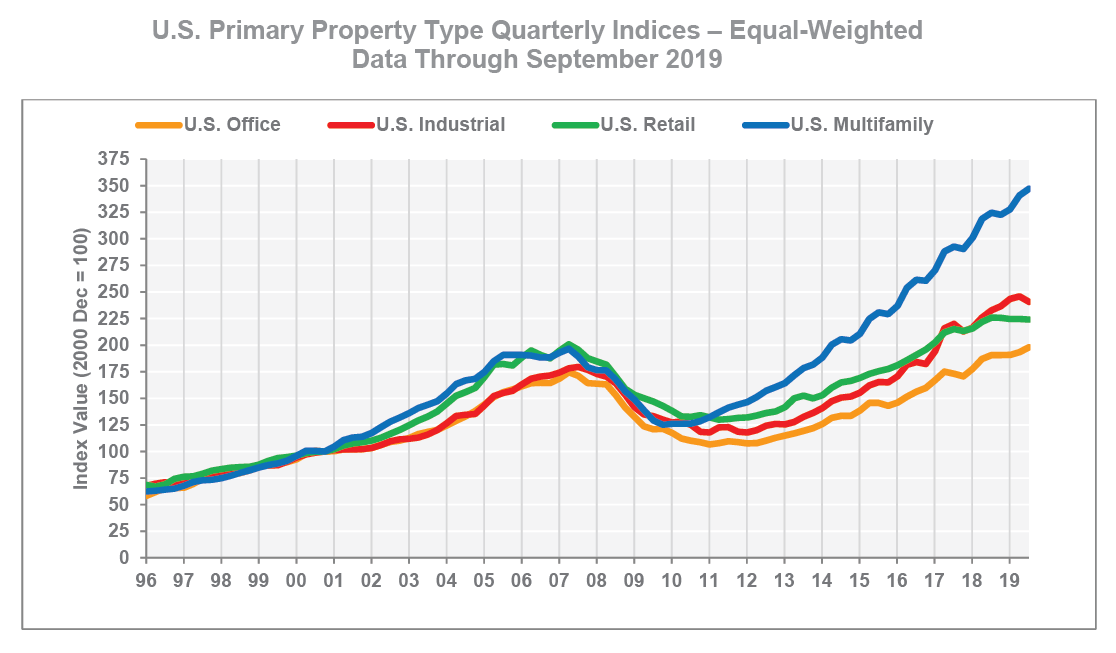
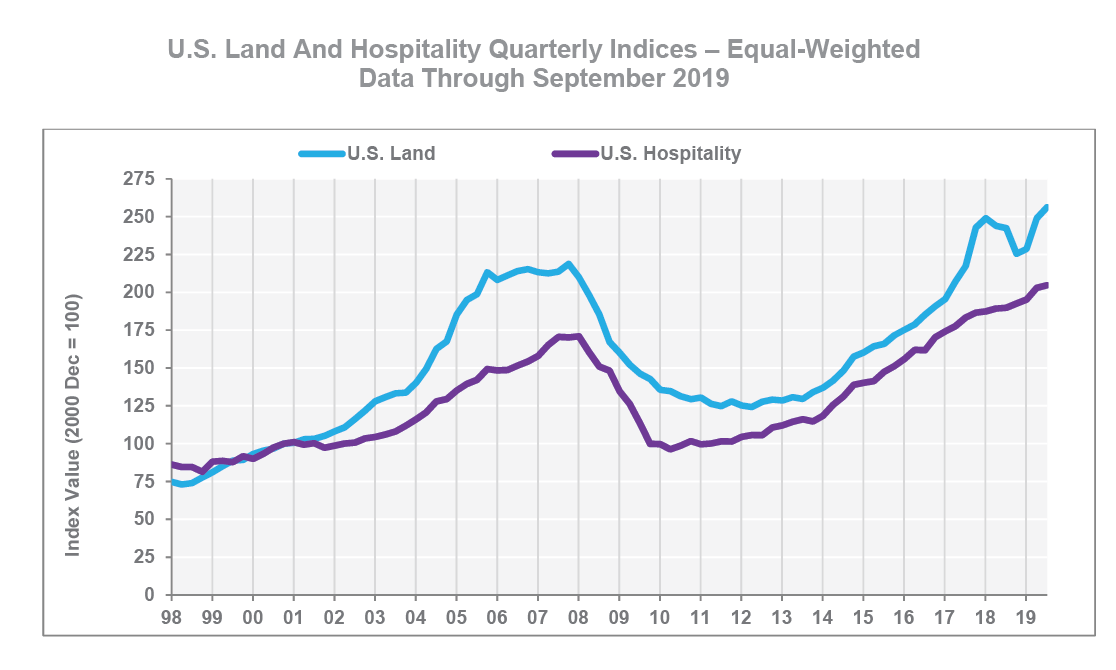
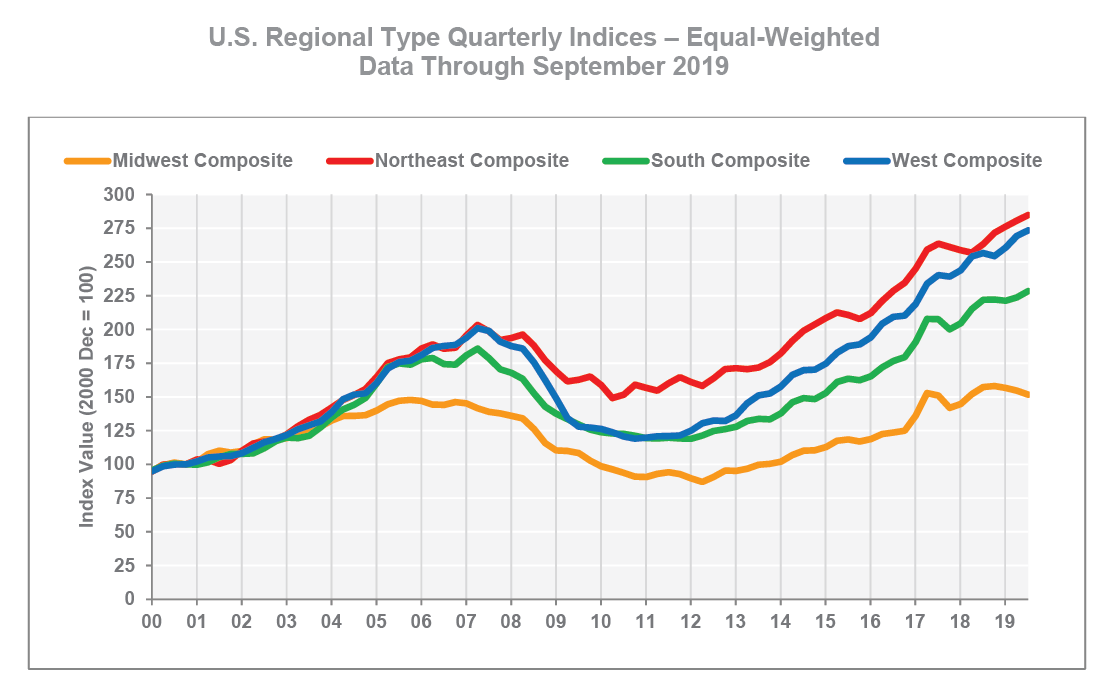
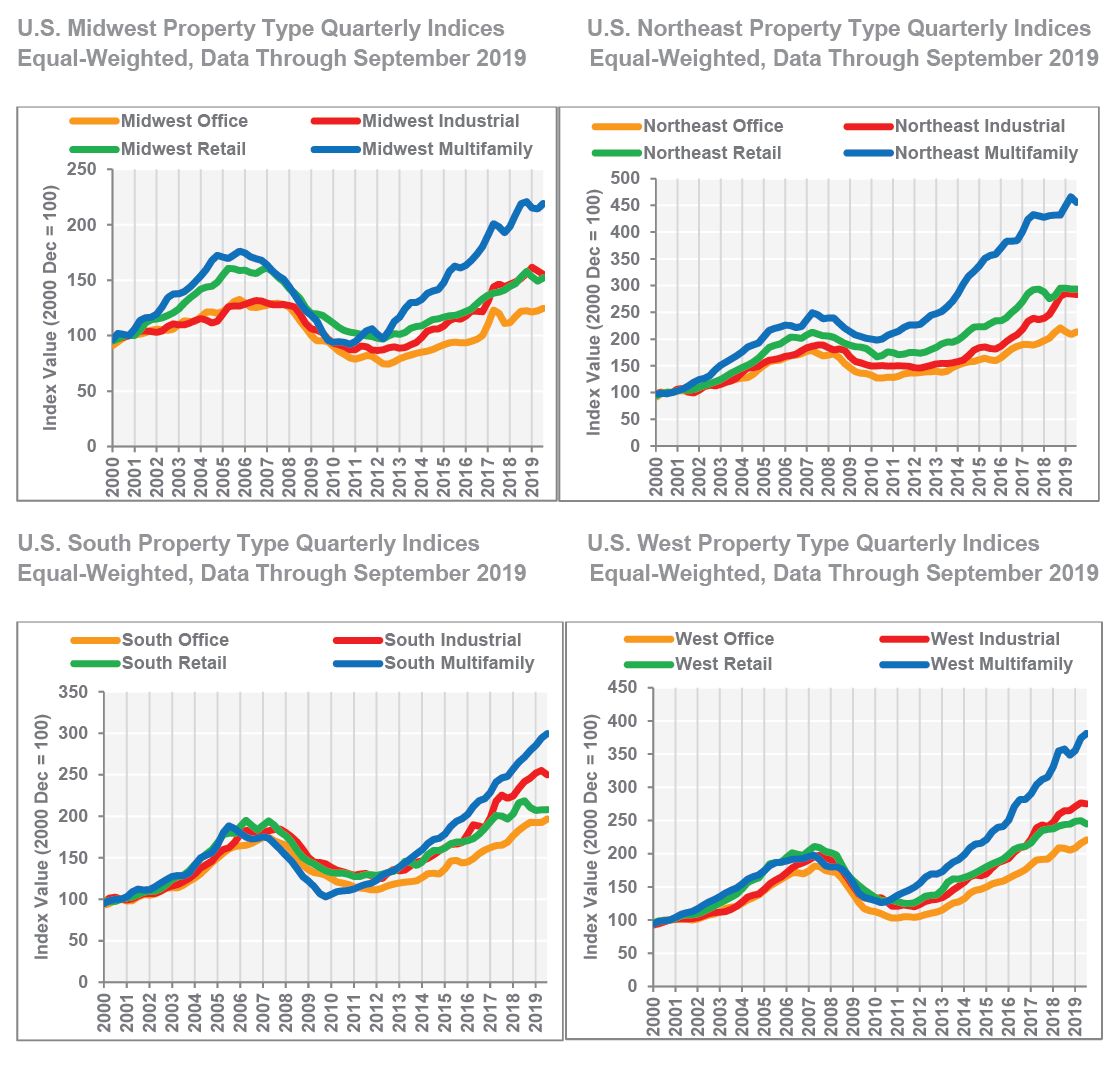

CCRSI National Results Highlights
OVERALL TRANSACTION VOLUME INCREASED 6.3% YEAR OVER YEAR THROUGH SEPTEMBER 2019. Composite pair volume of $150.9 billion in the 12- month period ending in September 2019 marked a 6.3% increase from the 12-month period ended in September 2018. The increase in volume was relatively broad-based with increases in both the General Commercial and Investment Grade segments.
-
COMPOSITE PRICE INDEX GAINS REMAINED STEADY THROUGH THE THIRD QUARTER. The value-weighted U.S. Composite Index, which reflects the larger asset sales common in the core markets that led the recovery, rose 0.5% in the third quarter, contributing to an annual gain of 8.2% in the 12-month period ended in September 2019. Meanwhile, the equal-weighted U.S. Composite Index, which reflects the more numerous but lower-priced property sales typical of secondary and tertiary markets, was up 2.5% in the third quarter and 7.1% in the 12-month period ended in September 2019. While price growth in the composite indices has slowed from the double-digit pace set earlier in the cycle, consistent, albeit more moderate gains, reflect strong underlying CRE fundamentals.
-
HEADWINDS FROM STORE CLOSURES AND COMPETITION FROM ECOMMERCE REMAINED A DRAG ON U.S. RETAIL INDEX PRICE GROWTH. The U.S. Retail index declined 0.2% in the third quarter of 2019, contributing to an annual loss of 0.8% in the 12-month period ended in September 2019, the weakest quarterly and 12-month rates among the four major property type indices. Recent weakness in pricing may signal the beginning of the necessary repurposing of unproductive retail by removing distressed sites from the competitive sphere. Conversely, well-located high-quality retail continues to command investor interest and pricing growth. Pricing in the Prime Retail Metros index, which includes the densely populated core markets, increased 3.5% in the 12-month period ended in September 2019.
-
THE WEST INDEX WAS A STRONG PERFORMER AMONG THE FOUR REGIONAL INDICES, WHILE THE MIDWEST LAGGED. The West regional index has consistently demonstrated strong growth among the regional indices in 2019, supported by its concentration of high-growth markets that have attracted outsized CRE demand and investor interest. The West Index increased 1.5% in the third quarter and 6.5% in the 12-month period ended in September 2019, the secondfastest quarterly and 12-month rates of the four regional indices. By contrast, price growth in the demographically weaker Midwest region fell 3.6% in the 12-month period ended in September 2019.
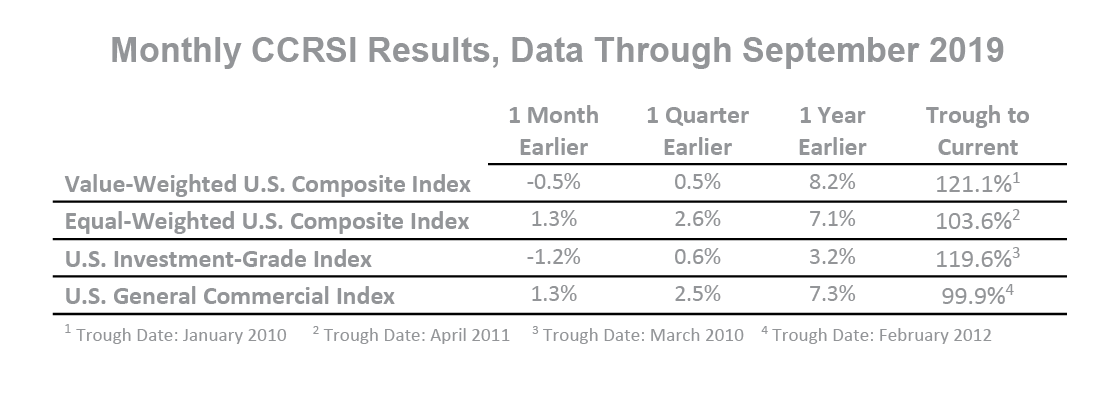
Quarterly CCRSI Property Type Results
-
PROPERTY SECTORS POSTED MODERATE GAINS IN THIRD QUARTER. The major property type indices posted solid growth of 3% or more in the 12-month period ended in September 2019, with the exception of the retail index, which lagged behind with a loss of 0.8%. The Prime Markets Indices within each property sector, which are dominated by the large, core, coastal metros, generally increased at a similar pace to the national property type indices during the 12-month period ended in September 2019, confirming that commercial property price gains have become broad-based.
-
THE MULTIFAMILY INDEX LED GROWTH AMONG THE FOUR MAJOR PROPERTY TYPES. The U.S. Multifamily Index expanded 1.8% in the third quarter and 6.9% in the 12-month period ended in September 2019, maintaining its position as one of the strongest property type indices this cycle. Capital continues to move down the risk spectrum, as secondary markets have seen strong pricing gains. The Prime Multifamily Metros Index increased at a similar rate of 6.3% in the 12-month period ended in September 2019.
-
SOLID GAINS PERSISTED IN THE INDUSTRIAL INDEX. Industrial fundamentals remained exceptionally healthy in the third quarter of 2019 as cyclically low vacancies below 5% have driven sustained above-trend rent growth. Pricing has increased, with the U.S. Industrial index up 3.4% in the 12-month period ended in September 2019. Core markets remained in favor as the Prime Industrial Metros Index advanced at a stronger 5% rate in the 12-month period ended in September 2019.
-
OFFICE PRICE GROWTH CONTINUED TO ACCELERATE IN THE THIRD QUARTER. U.S. Office Index growth accelerated to 2.4% in the third quarter, following 1.4% growth in the second quarter of 2019, rebounding from flat growth early in the COSTAR COMMERCIAL REPEAT-SALE INDICES OCTOBER 2019 Release (With Data through SEPTEMBER 2019) year. Office prices were up 3.8% in the 12-month period ended in September 2019. Price growth in the Prime Office Metros Index advanced at a modestly slower pace of 3.5% in the 12-month period ended in September 2019, as investors continue to look beyond core markets to demographically strong secondary markets in search of yield.
-
SECTOR HEADWINDS DAMPENED PRICE GROWTH IN THE RETAIL SECTOR. The U.S. Retail index declined 0.2% in the third quarter of 2019, contributing to an annual loss of 0.8% in the 12-month period ended in September 2019, the weakest quarterly and annual rates among the four major property type indices. An increasing number of retail transactions are being made for the value of the land, particularly for poorly-located assets. Well-located high-quality retail, conversely, continues to command investor interest and pricing growth. Pricing in the Prime Retail Metros index, which includes the densely populated core markets, increased 3.5% in the 12- month period ended in September 2019.
-
U.S. HOSPITALITY INDEX GROWTH WAS STEADY. The U.S. Hospitality Index was up 0.9% in the third quarter, contributing to an annual gain of 7.9% in the 12-month period ended in September 2019. Fundamentals remain in solid shape as national hotel occupancies remain well above average. In the third quarter 2019, the U.S. Hospitality Index was nearly 20% above its prerecession peak.
-
U.S. LAND INDEX GROWTH INCREASED 5.7%. The U.S. Land Index is the most volatile of the property type indices. After falling through most of 2018, the index rebounded to positive growth through the first three quarters of 2019, and registered 5.7% growth in the 12-month period ended in September 2019. In September 2019, the U.S. Land Index was 17.1% over its prior peak level on the strength of continued demand for development sites.
Quarterly CCRSI Regional Results
-
BROAD-BASED GROWTH ACROSS THE PROPERTY TYPES BOLSTERED WEST REGIONAL INDEX. The West Composite Index advanced 1.5% in the third quarter, the second-strongest quarterly growth rate after the South, and expanded 6.5% in the 12-month period ended in September 2019. The West region has exhibited the strongest momentum recently, with positive growth across all four property types in the most recent annual period. The West Multifamily and Office indices showed the strongest growth, of 6.6% and 5.9%, respectively, in the 12-month period ended in September 2019.
-
MULTIFAMILY, INDUSTRIAL SHOW STRONGEST GROWTH IN NORTHEAST. The Northeast Composite Index advanced 8.2% in the 12-month period ended in September 2019, the strongest annual growth rate among the four regions, but its outperformance was due in large part to strong growth in the Northeast Industrial Index. The Northeast Industrial Index was up 8% in the 12-month period ended in September 2019, the second-strongest annual growth rate among the 16 regional property type indices. Meanwhile, the Northeast Multifamily Index continued to post solid gains of 5.5% in the 12-month period ended in September 2019.
-
A HIGH CONCENTRATION OF FASTER GROWING SUNBELT MARKETS HAS LIFTED GROWTH IN THE SOUTH REGION. The South region exhibited solid gains in the last 12 months, led by the South Multifamily Index, which was up 10.4% in the 12-month period ended in September 2019, the only regional property type index to experience double-digit growth in that period. Meanwhile, the South Office Index was up by an above-average 4.4% while the South retail sector exhibited some weakness in the third quarter, which follows the national trend.
-
WEAKNESS IN THE RETAIL, MULTIFAMILY, AND INDUSTRIAL SEGMENTS HELD DOWN GROWTH IN THE MIDWEST REGIONAL INDEX. The Midwest Composite index fell 3.6% in the 12-month period ended in September 2019. Recent quarterly declines in the Midwest Retail, Multifamily, and Industrial indices were a drag on recent growth, while the Midwest Office Index was the only property type in the region to garner positive growth in the most recent quarterly and 12-month period. The Midwest Office Index advanced 1.9% in the third quarter and 2.1% in the 12-month period ended in September 2019.
About The CoStar Commercial Repeat-Sale Indices
The CoStar Commercial Repeat-Sale Indices (CCRSI) is the most comprehensive and accurate measure of commercial real estate prices in the United States. In addition to the national Composite Index (presented in both equal-weighted and value-weighted versions), national Investment-Grade Index, and national General Commercial Index, which we report monthly, we report quarterly on 30 sub-indices in the CoStar index family. The sub-indices include breakdowns by property sector (office, industrial, retail, multifamily, hospitality, and land), by region of the country (Northeast, South, Midwest, and West), by transaction size and quality (general commercial, investment-grade), and by market size (composite index of the prime market areas in the country).
The CoStar indices are constructed using a repeat sales methodology, widely considered the most accurate measure of price changes for real estate. This methodology measures the movement in the prices of commercial properties by collecting data on actual transaction prices. When a property is sold more than once, a sales pair is created. The prices from the first and second sales are then used to calculate price movement for the property. The aggregated price changes from all of the sales pairs are used to create a price index.
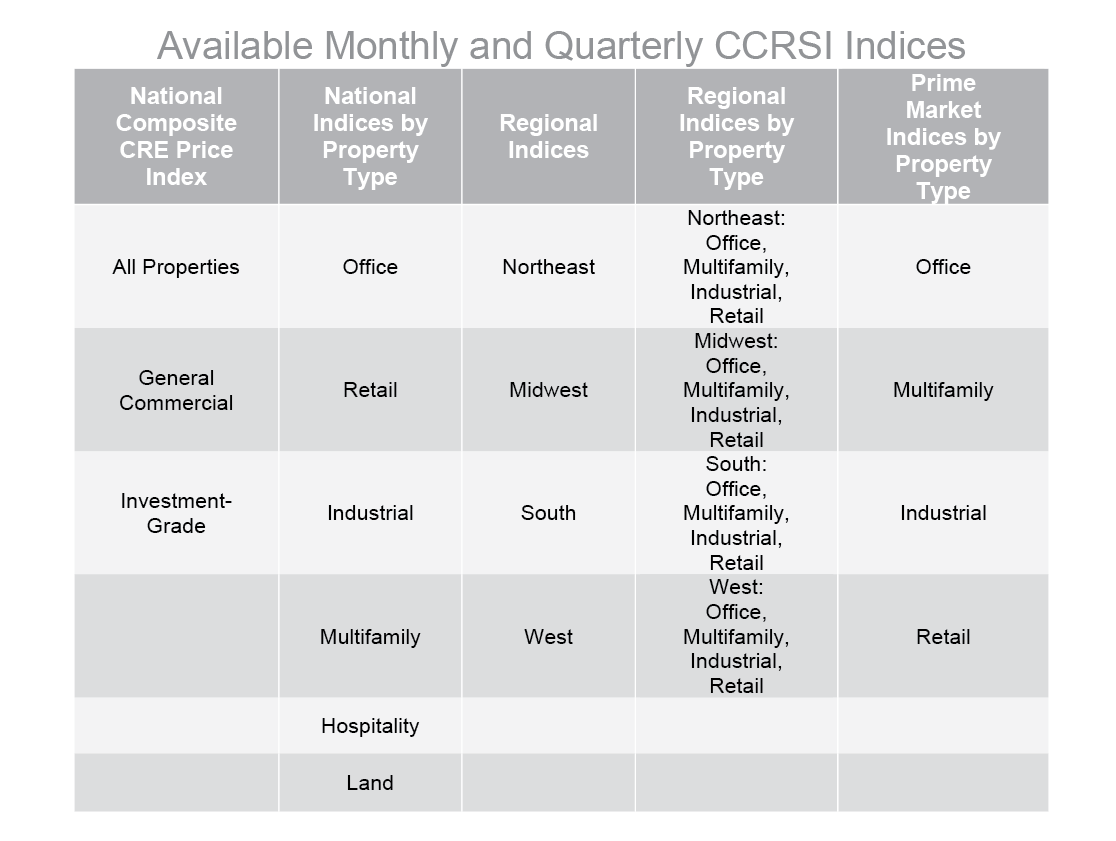

Media Contact:
Kendall Ridley, Senior Manager, External Communications, CoStar Group kridley@costar.com.
For more information about the CCRSI Indices, including the full accompanying data set and research methodology, legal notices and disclaimer, please visit https://costargroup.com/costar-news/ccrsi.
ABOUT COSTAR GROUP, INC.
CoStar Group, Inc. (NASDAQ: CSGP) is the leading provider of commercial real estate information, analytics and online marketplaces. Founded in 1987, CoStar conducts expansive, ongoing research to produce and maintain the largest and most comprehensive database of commercial real estate information. Our suite of online services enables clients to analyze, interpret and gain unmatched insight on commercial property values, market conditions and current availabilities. LoopNet is the most heavily trafficked commercial real estate marketplace online with over 6 million monthly unique visitors. Realla is the UK’s most comprehensive commercial property digital marketplace. Apartments.com, ApartmentFinder.com, ForRent.com, ApartmentHomeLiving.com, Westside Rentals, AFTER55.com, CorporateHousing.com, ForRentUniversity.com and Apartamentos.com form the premier online apartment resource for renters seeking great apartment homes and provide property managers and owners a proven platform for marketing their properties. CoStar Group’s websites attracted an average of over 51 million unique monthly visitors in aggregate in the third quarter of 2019. Headquartered in Washington, DC, CoStar maintains offices throughout the U.S. and in Europe and Canada with a staff of over 3,900 worldwide, including the industry’s largest professional research organization. For more information, visit www.costargroup.com.

